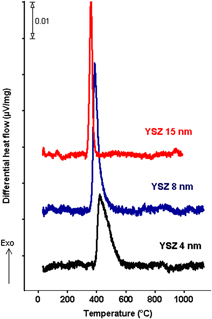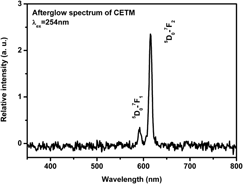Scanning electron microscopy image of SBA-15. [Y. Khaniani, A. Badiei, and G. Mohammadi Ziarani: Application of clickable nanoporous silica surface for immobilization of ionic liquids. p. 932.]
Invited Feature Paper
Observation of filament formation process of Cu/HfO2/Pt ReRAM structure by hard x-ray photoelectron spectroscopy under bias operation
-
- Published online by Cambridge University Press:
- 20 January 2012, pp. 869-878
-
- Article
- Export citation
Influence of laser interference patterning on microstructure and friction behavior of gold/yttria-stabilized zirconia nanocomposite thin films
-
- Published online by Cambridge University Press:
- 07 February 2012, pp. 879-885
-
- Article
- Export citation
Analysis of resistance switching and conductive filaments inside Cu-Ge-S using in situ transmission electron microscopy
-
- Published online by Cambridge University Press:
- 31 January 2012, pp. 886-896
-
- Article
- Export citation
Excitation spectrum of point defects in semiconductors studied by time-dependent density functional theory
-
- Published online by Cambridge University Press:
- 24 January 2012, pp. 897-909
-
- Article
- Export citation
Articles
Microwave dielectric properties of low loss and highly tunable Ba0.5Sr0.5Ti1−3y/2WyO3 ceramics
-
- Published online by Cambridge University Press:
- 12 January 2012, pp. 910-914
-
- Article
- Export citation
Crystal structure and microwave dielectric properties of low temperature sintered MgO ceramic with LiF addition
-
- Published online by Cambridge University Press:
- 06 February 2012, pp. 915-921
-
- Article
- Export citation
Tunable dielectric properties in Mn-doped LuFe2O4 system
-
- Published online by Cambridge University Press:
- 20 January 2012, pp. 922-927
-
- Article
- Export citation
Effects of Mg substitution on microstructure and electrical properties of NiMn2−xMgxO4 NTC ceramics
-
- Published online by Cambridge University Press:
- 10 February 2012, pp. 928-931
-
- Article
- Export citation
Application of clickable nanoporous silica surface for immobilization of ionic liquids
-
- Published online by Cambridge University Press:
- 16 January 2012, pp. 932-938
-
- Article
- Export citation
Yttria-stabilized zirconia crystallization in Al2O3/YSZ multilayers
-
- Published online by Cambridge University Press:
- 25 January 2012, pp. 939-943
-
- Article
- Export citation
Nanoscale structure of Ti1−xNbyO2 mixed-phase thin films: Distribution of crystal phase and dopants
-
- Published online by Cambridge University Press:
- 23 January 2012, pp. 944-950
-
- Article
- Export citation
Standing porous ZnO nanoplate-built hollow microspheres and kinetically controlled dissolution/crystal growth mechanism
-
- Published online by Cambridge University Press:
- 13 February 2012, pp. 951-958
-
- Article
- Export citation
Enhancement on afterglow properties of Eu3+ by Ti4+, Mg2+ incorporation in CaWO4 matrix
-
- Published online by Cambridge University Press:
- 07 February 2012, pp. 959-964
-
- Article
- Export citation
Activation of plasmons and polarons in solar control cesium tungsten bronze and reduced tungsten oxide nanoparticles
-
- Published online by Cambridge University Press:
- 10 February 2012, pp. 965-970
-
- Article
- Export citation
Characterization study of GaN-based epitaxial layer and light-emitting diode on nature-patterned sapphire substrate
-
- Published online by Cambridge University Press:
- 06 February 2012, pp. 971-977
-
- Article
- Export citation
Erratum
Localized recrystallization and cracking of lead-free solder interconnections under thermal cycling – ERRATUM
-
- Published online by Cambridge University Press:
- 17 February 2012, p. 978
-
- Article
-
- You have access
- HTML
- Export citation
Front Cover (OFC, IFC) and matter
JMR volume 27 issue 6 Cover and Front matter
-
- Published online by Cambridge University Press:
- 05 March 2012, pp. f1-f5
-
- Article
-
- You have access
- Export citation
Back Cover (OBC, IBC) and matter
JMR volume 27 issue 6 Cover and Back matter
-
- Published online by Cambridge University Press:
- 05 March 2012, pp. b1-b3
-
- Article
-
- You have access
- Export citation








 values strongly depended on the LiF content. As a result, the highest
values strongly depended on the LiF content. As a result, the highest  value of 282,230 GHz was obtained at
value of 282,230 GHz was obtained at 





 0) planes. Experiments have revealed the structural evolution: the formation of amorphous spheres in the initial reaction stage, followed by surface crystallization and nanoplate outward growth accompanied by inward dissolution of the amorphous spheres. Citrate in the precursor solution plays a dominant role in the formation of such porous ZnO hollow spheres. A model is presented, based on citrate-induced amorphous sphere formation and kinetically controlled dissolution and crystal growth. The model describes the formation of the hollow spheres, thermodynamically and kinetically.
0) planes. Experiments have revealed the structural evolution: the formation of amorphous spheres in the initial reaction stage, followed by surface crystallization and nanoplate outward growth accompanied by inward dissolution of the amorphous spheres. Citrate in the precursor solution plays a dominant role in the formation of such porous ZnO hollow spheres. A model is presented, based on citrate-induced amorphous sphere formation and kinetically controlled dissolution and crystal growth. The model describes the formation of the hollow spheres, thermodynamically and kinetically.


